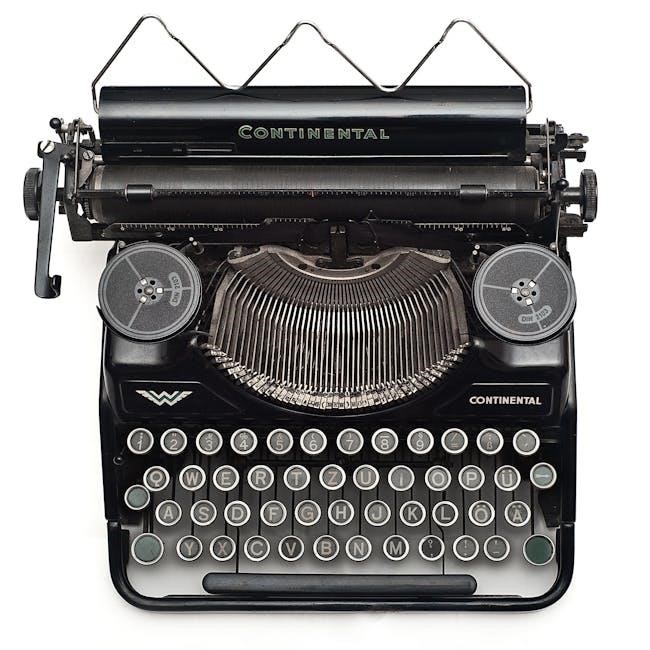Welcome to the Cuisinart Ice Cream Maker, a top choice for crafting delicious homemade desserts with ease and precision.
Whether you’re making classic ice cream, frozen yogurt, or sorbet, this machine offers simplicity and versatility for every dessert lover.
With models like the ICE-21 and ICE-20, it’s designed to churn perfect treats quickly, ensuring a creamy texture in just minutes.

Overview of the Cuisinart Ice Cream Maker
The Cuisinart Ice Cream Maker, including models like the ICE-20 and ICE-21, is a versatile kitchen appliance designed for homemade frozen treats. It features automatic operation, a double-insulated freezer bowl, and fast churning times, typically under 20 minutes. Perfect for ice cream, frozen yogurt, and sorbet, this machine allows users to create customizable desserts with ease. Its compact and user-friendly design makes it ideal for families and dessert enthusiasts alike, ensuring delicious and healthier options right at home. Easy to use and clean, it’s a great addition to any kitchen.
Why Choose the Cuisinart Ice Cream Maker
Choose the Cuisinart Ice Cream Maker for its unmatched convenience and versatility in creating homemade frozen desserts. With automatic operation, it simplifies the process, requiring minimal effort. The double-insulated freezer bowl ensures quick and efficient churning, while the compact design saves kitchen space. Perfect for ice cream, frozen yogurt, and sorbet, it offers customization options to suit every taste. Its ease of use and durability make it a top choice for families and dessert lovers, providing delicious results every time with minimal cleanup.

Key Features and Benefits
The Cuisinart Ice Cream Maker offers automatic operation, a double-insulated freezer bowl, and fast churning time, ensuring creamy results in minutes with minimal effort and cleanup.
Automatic Operation for Convenience
The Cuisinart Ice Cream Maker offers effortless operation, allowing you to create homemade desserts with minimal effort. Simply pour your ingredients into the machine, turn it on, and let it do the work. This feature makes it ideal for both novice and experienced users, ensuring consistent results every time.
The automatic operation eliminates the need for manual churning, saving you time and effort. With models like the ICE-21 and ICE-20, you can enjoy perfectly churned ice cream, frozen yogurt, or sorbet in less than 20 minutes. Its user-friendly design ensures a smooth experience for everyone, including families with children, making it a delightful addition to any kitchen.
Double Insulated Freezer Bowl
The Cuisinart Ice Cream Maker features a double insulated freezer bowl, designed to maintain optimal temperature during the churning process. This ensures a smoother, creamier texture for your homemade ice cream, frozen yogurt, or sorbet. The insulation keeps the bowl cold for a longer period, allowing faster freezing and even churning. Simply pre-freeze the bowl overnight, add your ingredients, and let the machine work its magic. This innovative design enhances efficiency and convenience, making it easier to achieve professional-quality results at home.
Fast Churning Time
The Cuisinart Ice Cream Maker stands out for its fast churning time, producing delicious frozen treats in under 20 minutes. Its efficient design ensures quick results without compromising on quality. Whether you’re making ice cream, sorbet, or frozen yogurt, the machine works rapidly to churn ingredients into a smooth, consistent texture. This feature makes it ideal for busy households or those who want to enjoy fresh desserts with minimal wait time. The quick process also helps preserve the freshness and flavor of your ingredients, ensuring a delightful experience every time.

Assembly and Preparation
Assembly is quick and straightforward, requiring minimal effort to secure the spindle and paddle. Organize ingredients beforehand for a seamless experience with your Cuisinart ICE-21 or ICE-20.
Unboxing and Initial Setup
Upon unboxing, carefully inspect all components, including the motor unit, freezer bowl, and paddle. Ensure the spindle is securely attached to the motor unit’s base for proper operation. Wash all parts with warm, soapy water before first use. Dry thoroughly to prevent any moisture issues. Place the freezer bowl in the freezer for at least 6 hours to pre-chill, ensuring optimal churning performance. This setup process guarantees a smooth start to your ice cream-making journey with the Cuisinart ICE-21 or ICE-20.
Understanding the Components
The Cuisinart Ice Cream Maker consists of key parts: the motor unit, freezer bowl, paddle, and spindle. The motor unit powers the machine, while the double-insulated freezer bowl ensures even freezing. The paddle mixes ingredients for a smooth texture, and the spindle connects it to the motor. These components work together to churn ingredients into creamy desserts. Understanding each part’s role is essential for proper assembly and operation, ensuring you achieve the best results with your Cuisinart ICE-21 or ICE-20 model.
Step-by-Step Assembly Guide
Begin by securing the spindle to the motor unit or lid, ensuring it’s tightly fastened. Next, attach the paddle to the spindle, aligning it properly for even mixing. Place the double-insulated freezer bowl onto the motor base, making sure it clicks into position. Finally, pour your prepared ingredients into the bowl and start the machine. Always refer to the manual for specific model instructions, such as the ICE-21 or ICE-20, to ensure correct assembly and optimal performance. Proper alignment and secure fitting are crucial for smooth operation.

Operating the Cuisinart Ice Cream Maker
Turn on the machine, pour ingredients into the spout, and let it churn. The automatic feature ensures hands-free operation, delivering creamy desserts in under 20 minutes.
Pre-Operation Checks
Before using your Cuisinart Ice Cream Maker, ensure all components are secure and ready. Check that the spindle is firmly attached to the motor unit and the paddle is properly aligned. Verify that the freezer bowl is pre-chilled for at least 6 hours if required by your model. Gather all ingredients and ensure they are pre-measured and chilled. Make sure the machine is placed on a stable, even surface. Lastly, review the recipe and instructions to confirm everything is prepared correctly for a smooth operation.
Adding Ingredients
When using your Cuisinart Ice Cream Maker, ensure the machine is turned on before adding ingredients to the freezer bowl for proper mixing. Add pre-measured, chilled ingredients through the spout, allowing even incorporation. Avoid overloading the bowl to maintain efficiency. Keep ingredients ready and within reach to streamline the process. Proper addition ensures a smooth and consistent final product, making your homemade desserts a success every time.

Starting the Machine
Once all ingredients are prepared, ensure the freezer bowl is securely placed under the motor unit. Attach the paddle to the spindle and lock it in place. Plug in the machine and turn it on using the power switch. The machine will begin churning automatically, creating a smooth and creamy texture. Always follow the manufacturer’s guidelines for operation to ensure optimal performance. The machine will handle the rest, producing delicious results in minutes. Proper setup ensures safe and efficient operation.
Monitoring the Churning Process
While the machine operates, monitor the churning process to ensure everything runs smoothly. The transparent lid allows you to view the mixture as it transforms. You’ll hear the motor working and see the paddle moving. The machine will stop automatically once the churning is complete, typically within 15-20 minutes. Check the consistency by lifting the lid slightly. If the mixture is too runny, let it churn a few more minutes. Avoid overfilling the bowl, as this can affect performance. Always refer to the manual for troubleshooting tips if needed. Proper monitoring ensures perfect results.

Recipe Ideas and Customization
Explore endless possibilities with classic recipes, frozen yogurt, and sorbet. Customize flavors by adding mix-ins like fruits, nuts, or cocoa for unique treats tailored to your taste.
Classic Ice Cream Recipes
Start with timeless favorites like vanilla, chocolate, or strawberry ice cream. These simple yet delicious recipes are perfect for beginners and loved by everyone.
Combine cream, sugar, and flavorings, then churn until smooth. For added texture, mix in chocolate chips, nuts, or fruit pieces during the final stages of churning.
Classic recipes provide a foundation for creativity, allowing you to experiment with unique flavors and ingredients for personalized treats. Enjoy the perfect blend of tradition and innovation!
Frozen Yogurt and Sorbet Options
Expand your dessert options with the Cuisinart Ice Cream Maker by crafting delicious frozen yogurt and sorbet. Frozen yogurt offers a lighter, healthier alternative to traditional ice cream, while sorbet provides a fruity, dairy-free treat.
Both options are easy to make—simply add your preferred ingredients, such as yogurt or pureed fruit, to the machine. The automatic churning process ensures a smooth, even texture in minutes.
Customize flavors with mix-ins like berries, nuts, or cocoa powder for added taste and texture. These options are perfect for dietary restrictions or refreshing summer treats.
Customizing Flavors
Customizing flavors with your Cuisinart Ice Cream Maker is effortless and fun. Experiment with unique ingredients like cocoa powder for chocolate ice cream or vanilla extract for a classic taste.
Add mix-ins such as berries, nuts, or candy pieces toward the end of the churning process for a personalized touch. For a lighter option, incorporate fresh fruit purees or citrus zest.
With endless possibilities, you can create vegan-friendly or dairy-free versions using plant-based milks. Layer flavors in the freezer for a multi-colored, multi-flavored dessert. The machine’s versatility ensures every batch is tailored to your taste.
Troubleshooting Common Issues
If the machine isn’t turning on, ensure it’s properly plugged in and all parts are securely assembled. If the motor is noisy, check for obstructions or uneven balancing.
If ice cream isn’t churning, verify that the freezer bowl is fully frozen and ingredients are at the correct temperature. Overloaded machines may struggle, so avoid excess mix.
For icy textures, ensure ingredients are cold but not frozen solid. If the paddle isn’t moving, make sure it’s securely attached to the spindle.
Refer to the manual for detailed solutions, and always follow safety guidelines to prevent damage or injury.

Maintenance and Storage
Regularly clean the machine with warm, soapy water and dry thoroughly. Store the freezer bowl in a dry place, and keep components organized for easy access.
Cleaning the Machine
Cleaning your Cuisinart Ice Cream Maker is essential for maintaining hygiene and performance. After each use, wash the freezer bowl, lid, and paddle with warm, soapy water. Avoid using abrasive cleaners or scourers, as they may damage the surfaces. Rinse thoroughly and dry with a soft cloth to prevent water spots. For tough residue, soak parts in warm water before scrubbing gently. Regular cleaning ensures your machine remains in top condition and prevents any lingering flavors from affecting future batches. Always check for stubborn stains and clean them promptly to maintain optimal functionality. Cleaning regularly also extends the lifespan of your ice cream maker and keeps it ready for the next use.
Storing the Ice Cream Maker
Proper storage of your Cuisinart Ice Cream Maker ensures its longevity and performance. After cleaning, store the machine in a cool, dry place, away from direct sunlight. The freezer bowl should be kept in the freezer if you plan to use it soon or in a dry location otherwise. Always detach the cord and store it separately to prevent tangling. Avoid stacking heavy objects on the machine to avoid damage. Regularly inspect stored parts for moisture or dust and address any issues promptly. Proper storage maintains the machine’s efficiency and readiness for future use.
Regular Maintenance Tips
Regular maintenance ensures your Cuisinart Ice Cream Maker performs optimally. After each use, thoroughly clean and dry all components to prevent residue buildup. Lubricate moving parts occasionally to maintain smooth operation. Check the paddle and spindle for wear and replace if necessary. Store the freezer bowl properly to avoid moisture damage. Descale the machine if you notice mineral buildup. Always inspect the cord and plug for damage before use. Regular checks and upkeep will extend the lifespan of your ice cream maker and ensure consistent results. Proper care ensures years of delicious homemade desserts.

Warranty and Support
The Cuisinart Ice Cream Maker is backed by a limited warranty covering defects in materials and workmanship. Customer support is available for troubleshooting and inquiries.
Understanding the Warranty
The Cuisinart Ice Cream Maker is warranted to be free of defects in materials and workmanship under normal home use for a specified period. This warranty covers manufacturing defects, ensuring your machine performs as promised. Coverage typically lasts for three years from the date of purchase, offering peace of mind for your investment. The warranty does not apply to misuse, accidental damage, or wear and tear. To validate your warranty, register your product with Cuisinart and retain your purchase receipt. Contact customer support for warranty claims or inquiries.
Customer Support Options
Cuisinart offers comprehensive customer support to ensure a smooth experience with your ice cream maker. You can contact their support team via phone, email, or live chat for assistance with troubleshooting, maintenance, or general inquiries. Additionally, Cuisinart provides online resources, including user manuals, troubleshooting guides, and FAQs, to help you resolve issues independently. Their dedicated support team is available to address concerns and provide guidance, ensuring your ice cream maker continues to perform optimally. For replacement parts or repairs, reach out to their customer service for prompt solutions.
The Cuisinart Ice Cream Maker offers convenience, speed, and versatility, perfect for crafting delicious homemade desserts with ease, making it a must-have for every dessert lover.
Final Tips for Using Your Cuisinart Ice Cream Maker
- Always pre-freeze the double-insulated bowl for at least 6 hours before use for optimal results.
- Use high-quality ingredients to ensure the best flavor and texture in your frozen treats.
- Monitor the churning process closely to avoid over-mixing, which can lead to icy textures.
- Experiment with unique flavor combinations to create personalized desserts.
- Regularly clean and maintain the machine to extend its lifespan and performance.

Exploring Advanced Features
The Cuisinart Ice Cream Maker goes beyond basic functionality, offering advanced features that elevate your dessert-making experience.
- Automatic operation allows for hands-free churning, ensuring consistent results every time.
- The double-insulated freezer bowl enables faster freezing and creamier textures without pre-freezing.
- Customizable settings let you adjust churning time and speed for different dessert types.
- The machine supports add-ins like mix-ins or flavorings mid-churn for unique creations.
- Advanced models include timers and automatic shut-off for convenience.
These features make it easy to experiment with intricate recipes and achieve professional-quality results at home.


























































































